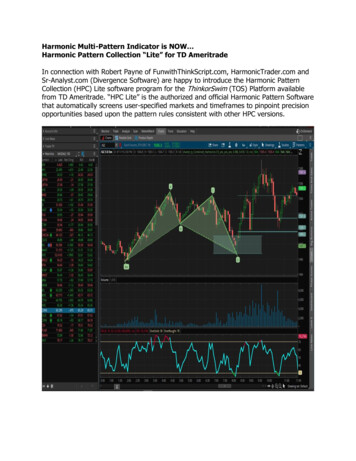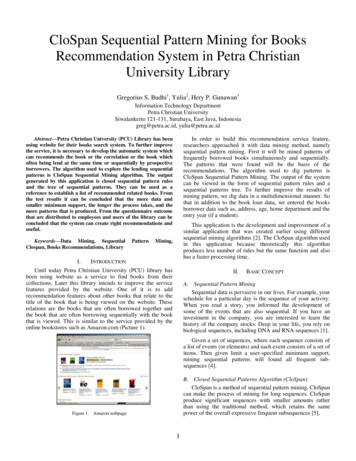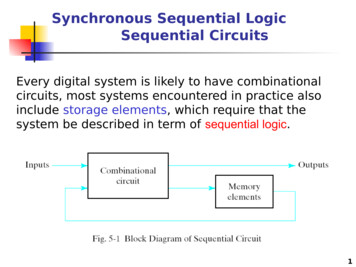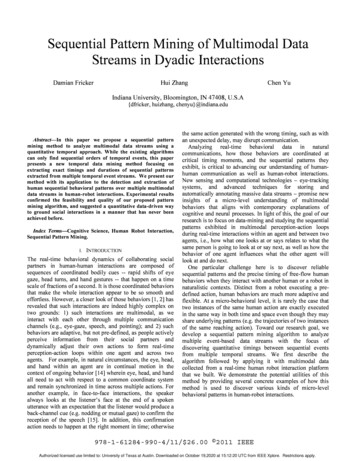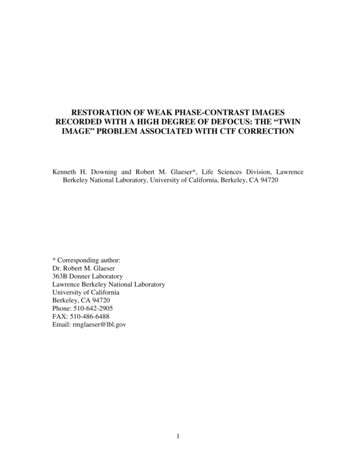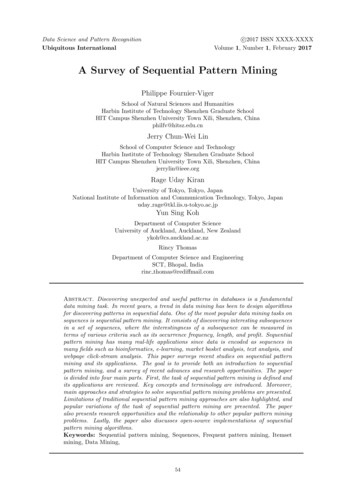
Transcription
c 2017 ISSN XXXX-XXXXVolume 1, Number 1, February 2017Data Science and Pattern RecognitionUbiquitous InternationalA Survey of Sequential Pattern MiningPhilippe Fournier-VigerSchool of Natural Sciences and HumanitiesHarbin Institute of Technology Shenzhen Graduate SchoolHIT Campus Shenzhen University Town Xili, Shenzhen, Chinaphilfv@hitsz.edu.cnJerry Chun-Wei LinSchool of Computer Science and TechnologyHarbin Institute of Technology Shenzhen Graduate SchoolHIT Campus Shenzhen University Town Xili, Shenzhen, Chinajerrylin@ieee.orgRage Uday KiranUniversity of Tokyo, Tokyo, JapanNational Institute of Information and Communication Technology, Tokyo, Japanuday rage@tkl.iis.u-tokyo.ac.jpYun Sing KohDepartment of Computer ScienceUniversity of Auckland, Auckland, New Zealandykoh@cs.auckland.ac.nzRincy ThomasDepartment of Computer Science and EngineeringSCT, Bhopal, Indiarinc thomas@rediffmail.comAbstract. Discovering unexpected and useful patterns in databases is a fundamentaldata mining task. In recent years, a trend in data mining has been to design algorithmsfor discovering patterns in sequential data. One of the most popular data mining tasks onsequences is sequential pattern mining. It consists of discovering interesting subsequencesin a set of sequences, where the interestingness of a subsequence can be measured interms of various criteria such as its occurrence frequency, length, and profit. Sequentialpattern mining has many real-life applications since data is encoded as sequences inmany fields such as bioinformatics, e-learning, market basket analysis, text analysis, andwebpage click-stream analysis. This paper surveys recent studies on sequential patternmining and its applications. The goal is to provide both an introduction to sequentialpattern mining, and a survey of recent advances and research opportunities. The paperis divided into four main parts. First, the task of sequential pattern mining is defined andits applications are reviewed. Key concepts and terminology are introduced. Moreover,main approaches and strategies to solve sequential pattern mining problems are presented.Limitations of traditional sequential pattern mining approaches are also highlighted, andpopular variations of the task of sequential pattern mining are presented. The paperalso presents research opportunities and the relationship to other popular pattern miningproblems. Lastly, the paper also discusses open-source implementations of sequentialpattern mining algorithms.Keywords: Sequential pattern mining, Sequences, Frequent pattern mining, Itemsetmining, Data Mining,54
A Survey of Sequential Pattern Mining551. Introduction. Data mining consists of extracting information from data stored in databases to understand the data and/or take decisions. Some of the most fundamental data mining tasks are clustering,classification, outlier analysis, and pattern mining [6, 58]. Pattern mining consists of discovering interesting, useful, and unexpected patterns in databases. This field of research has emerged in the 1990s withthe seminal paper of Agrawal and Srikant [1]. That paper introduced the Apriori algorithm, designed forfinding frequent itemsets, that is groups of items (symbols) frequently appearing together in a databaseof customer transactions. For example, the Apriori algorithm can be used to discover patterns such as{carrot juice, salad, kiwi} in a retail store database, indicating that these products are frequently boughttogether by customers.The interest in pattern mining techniques comes from their ability to discover patterns that can behidden in large databases and that are interpretable by humans, and hence useful for understandingthe data and for decision-making. For example, a pattern {milk, chocolate cookies} can be used tounderstand customer behavior and take strategic decisions to increase sales such as co-promoting productsand offering discounts.Although pattern mining has become very popular due to its applications in many domains, severalpattern mining techniques such as those for frequent itemset mining [1, 53, 116, 86, 106] and associationrule mining [1] are aimed at analyzing data, where the sequential ordering of events is not taken intoaccount. Thus, if such pattern mining techniques are applied on data with time or sequential orderinginformation, this information will be ignored. This may result in the failure to discover important patternsin the data, or finding patterns that may not be useful because they ignore the sequential relationshipbetween events or elements. In many domains, the ordering of events or elements is important. Forexample, to analyze texts, it is often relevant to consider the order of words in sentences [94]. In networkintrusion detection, the order of events is also important [93].To address this issue, the task of sequential pattern mining was proposed. It is a prominent solutionfor analyzing sequential data [2, 98, 117, 4, 51, 89, 3, 47, 30, 111, 31, 32, 27, 28, 22, 100, 79]. Itconsists of discovering interesting subsequences in a set of sequences, where the interestingness of asubsequence can be measured in terms of various criteria such as its occurrence frequency, length, andprofit. Sequential pattern mining has numerous real-life applications due to the fact that data is naturallyencoded as sequences of symbols in many fields such as bioinformatics [108], e-learning [22], market basketanalysis [98], text analysis [94], energy reduction in smarthomes [104], webpage click-stream analysis [25]and e-learning [124]. Moreover, sequential pattern mining can also be applied to time series (e.g. stockdata), when discretization is performed as a pre-processing step [66]Sequential pattern mining is a very active research topic, where hundreds of papers present newalgorithms and applications each year, including numerous extensions of sequential pattern mining forspecific needs. Because of this, it can be difficult for newcomers to this field to get an overview of thefield. To address this issue, a survey has been published in 2010 [79]. However, this survey is no longerup-to-date as it does not discuss the most recent techniques, advances and challenges in the field. In thispaper, we aim to address this issue by presenting an up-to-date survey of sequential pattern mining thatcan serve both as an introduction and as a guide to recent advances and opportunities in the field. Therest of this paper is organized as follows. The next section describes the problem of sequential patternmining, and the main techniques employed in sequential pattern mining. Then, the paper discussespopular extensions of the problem of sequential pattern mining, and other problems in data mining thatare closely related to sequential pattern mining. Then, the paper discusses research opportunities andopen-source implementations of sequential pattern mining algorithms. Finally, a conclusion is drawn.2. Sequential Pattern Mining. Two types of sequential data are commonly used in data mining [58]:time-series and sequences. A time-series is an ordered list of numbers, while a sequence is an orderedlist of nominal values (symbols). For example, Fig. 1 (left) shows a time-series representing amounts ofmoney, while Fig. 1 (right) depicts a sequence of symbols (letters). Both time-series and sequences areused in many domains. For instance, time-series are often used to represent data such as stock prices,temperature readings, and electricity consumption readings, while sequences are used to represent datasuch as sentences in texts (sequences of words), sequences of items purchased by customers in retail stores,and sequences of webpages visited by users.The problem of sequential pattern mining was proposed by Agrawal and Srikant [98], as the problemof mining interesting subsequences in a set of sequences. Although, it was originally designed to beapplied to sequences, it can also be applied to time series after converting time-series to sequences usingdiscretization techniques. For example, Fig. 1 (right) shows a sequence representing the time-seriesshown in Fig. 1 (left), where the symbols a, b, c, d are defined as an increase of 10 , a decrease of 10 , an
56P. Fournier-Viger, Jerry C. W. Lin, R. U. Kiran, Y. S. Koh and R. Thomasincrease of 20 , and a decrease of 20 , respectively. There exists several ways of transforming time-seriesto sequences. Some of the most popular techniques are the SAX [66] and iSAX [17] algorithms. For moredetails about time-series transformations, the reader may refer to a survey of methods for time-seriesdata mining [23].A -02-01a, b , a, b , c, a, b, d2016-01-01Profit ( )A time-seriesFigure 1. A time-series (left) and a sequence (right)In this paper, we are interested by sequences, as it is the type of data used in sequential pattern mining.Definitions related to sequences are given next with some illustrative examples. Let there be a set ofitems (symbols) I {i1 , i2 , . . . im }. An itemset X is a set of items such that X I. Let the notation X denote the set cardinality or, in other words, the number of items in an itemset X. An itemset Xis said to be of length k or a k-itemset if it contains k items ( X k). For example, consider that theset of symbols I {a, b, c, d, e, f, g} represents the products sold in a retail store. The set {a, b, c} is anitemset containing three items, which may represent the purchases made by a customer on a given day.Without loss of generality, assume that there exists a total order on items such as the lexicographicalorder (e.g. a b c d e f g). A sequence is an ordered list of itemsets s hI1 , I2 , ., In i suchthat Ik I (1 k n). For example, consider the sequence h{a, b}, {c}, {f, g}, {g}, {e}i representingfive transactions made by a customer at a retail store. Each single letter represents an item. Itemsbetween curly brackets represent an itemset. This sequence indicates that a customer purchased itemsa and b at the same time, then bought item c, then purchased items f and g at the same time, thenpurchased g, and finally purchased e.A sequence sa hA1 , A2 , . . . , An i is said to be of length k or a k-sequence if it contains k items, or inother words if k A1 A2 · · · An . For example, the sequence h{a, b}, {c}, {f, g}, {g}, {e}i is a7-sequence.A sequence database SDB is a list of sequences SDB hs1 , s2 , ., sp i having sequence identifiers(SIDs) 1, 2.p. For instance, a sequence database is shown in Table 1, which contains four sequenceshaving the SIDs 1, 2, 3 and 4. These sequences could, for example, represent purchases made by fourcustomers.Table 1. A sequence databaseSID1234Sequenceh{a, b}, {c}, {f, g}, {g}, {e}ih{a, d}, {c}, {b}, {a, b, e, f }ih{a}, {b}, {f,},g},{e}{e}ih{b}, {f, g}iA sequence sa hA1 , A2 , ., An i is said to be contained in another sequence sb hB1 , B2 , ., Bm i if andonly if there exist integers 1 i1 i2 . in m such that A1 Bi1 , A2 Bi2 , ., An Bin (denotedas sa v sb ). For example, the sequence h{b}, {f, g}i is contained in sequence h{a, b}, {c}, {f, g}, {g}, {e}i,while the sequence h{b}, {g}, {f }i is not. If a sequence sa is contained in a sequence sb , sa is said to bea subsequence of sb .The goal of sequential pattern mining is to discover interesting subsequences in a sequence database,that is sequential relationships between items that are interesting for the user. Various measures can be
A Survey of Sequential Pattern Mining57Table 2. Sequential patterns found in the database of Table. 1Patternh{a}ih{a}, {g}ih{a}, {g}, {e}ih{a}, {f }ih{a}, {f }, {e}ih{a}, {c}ih{a}, {c}, {f }ih{a}, {c}, {e}ih{a}, {b}ih{a}, {b}, {f }ih{a}, {b}, {e}ih{a}, {e}ih{a, b}ih{b}ih{b}, {g}ih{b}, {g}, {e}ih{b}, {f }ih{b}, {f, g}ih{b}, {f }, {e}ih{b}, {e}ih{c}ih{c}, {f }ih{c}, {e}ih{e}ih{f }ih{f, g}ih{f }, {e}ih{g}ih{g}, yesyesyesyesyesyesyesyesused to assess how interesting a subsequence is. In the original problem of sequential pattern mining,the support measure is used. The support (or absolute support) of a sequence sa in a sequence databaseSDB is defined as the number of sequences that contain sa , and is denoted by sup(sa ). In other words,sup(sa ) {s s v sa s SDB} . For example, the support of the sequence h{b}, {f, g}i in the databaseof Table 1 is 3 because this sequence appears in three sequences (Sequence 1,2 and 4). Note that somepapers define the support of a sequence X as a ratio. This definition called the relative support isrelSup(sa ) sup(sa )/ SDB , that is the number of sequences containing sa divided by the number ofsequences in the database. For example, the relative support of the itemset h{b}, {f, g}i is 0.75.Sequential pattern mining is the task of finding all frequent subsequences in a sequence database. Asequence s is said to be a frequent sequence or a sequential pattern if and only if sup(s) minsup, fora threshold minsup set by the user [98]. The assumption is that frequent subsequences are interestingto the user. For instance, consider the database of Table 1, and assume that the user sets minsup 2to find all subsequences appearing in at least two sequences. Table 2 shows the 29 sequential patternsfound in the database for minsup 2, and their support values. For example, the patterns h{a}i andh{a}, {g}i are frequent and have a support of 3 and 2 sequences, respectively.The task of sequential pattern mining is an enumeration problem. It aims at enumerating all patterns(subsequences) that have a support no less than the minimum support threshold set by the user. Thus,there is always a single correct answer to a sequential pattern mining problem. Discovering sequentialpatterns is a hard problem. To solve this problem, the naive approach is to calculate the support of allpossible subsequences in a sequence database to then output only those meeting the minimum supportconstraint specified by the user. However, such a naive approach is inefficient because the number ofsubsequences can be very large. A sequence containing q items in a sequence database can have upto 2q 1 distinct subsequences. Because of this, applying the naive approach to solve the sequential
58P. Fournier-Viger, Jerry C. W. Lin, R. U. Kiran, Y. S. Koh and R. Thomaspattern mining problem is unrealistic for most real-life sequence databases. Hence, it is necessary todesign efficient algorithms to avoid exploring the search space of all possible subsequences.Numerous algorithms have been designed to discover sequential patterns in sequence databases. Someof the most popular are GSP [98], Spade [117], PrefixSpan [89], Spam [3], Lapin [111], CM-Spam [30], andCM-Spade [30]. All these sequential pattern mining algorithms take as input a sequence database and aminimum support threshold (chosen by the user), and output the set of frequent sequential patterns. It isimportant to note that there is always only one correct answer to a sequential pattern mining task (for agiven sequence database and threshold value). Thus, all sequential pattern mining algorithms return thesame set of sequential patterns if they are run with the same parameter on the same database. Hence,the difference between the various algorithms is not their output, but it is how each algorithm discoversthe sequential patterns. Various algorithms utilize different strategies and data structures to search forsequential patterns efficiently. As a result, some algorithms are more efficient than others.In the following pages, we give an overview of the main techniques employed by sequential patternmining algorithms, and discusses their advantages and limitations. The following section then discussesvariations of the sequential pattern mining problem.Before introducing the specific techniques, it is important to present a few key definitions related tothe search for sequential patterns. In general, sequential pattern mining algorithms assume that thereexists a total order on items denoted as , which represent the order for processing items in a database tofind the sequential patterns. For example, consider a database containing the items {a, b, c}. The orderfor processing items could be defined as the lexicographical order (e.g. c b a). But any other totalorder on items from I such as the order of decreasing or increasing support could be used. Note thatthe choice of the order has no influence on the final result produced by a sequential pattern miningalgorithm. The order is used so that algorithms follow a specific order to explore potential sequentialpatterns, and thus avoid considering the same pattern more than once.All sequential pattern mining algorithms explore the search space of sequential patterns by performingtwo basic operations called s-extensions and i-extensions. These operations are used to generate a(k 1)-sequence (a sequence containing k 1 items) from a k-sequence. These operations are definedas follows. A sequence sa hA1 , A2 , ., An i is a prefix of a sequence sb hB1 , B2 , ., Bm i, if n m,A1 B1 , A2 B2 , ., An 1 Bn 1 and An is equal to the first An items of Bn according to theorder. For example, the sequence h{a}i is a prefix of the sequence h{a, b}, {c}i, and the sequenceh{a}{c}i is a prefix of the sequence h{a}, {c, d}i A sequence sb is said to be an s-extension of a sequencesa hI1 , I2 , .Ih i with an item x, if sb hI1 , I2 , .Ih , {x}i, i.e. sa is a prefix of sb and the item x appearsin an itemset occuring after all the itemsets of sa . For example, the sequence h{a}, {a}i and h{a}, {b}iand h{a}, {c}i are s-extensions of the sequence h{a}i. A sequence sc is said to be an i-extension of sawith an item x, if sc hI1 , I2 , .Ih {x}i, i.e. sa is a prefix of sc and the item x is appended to the lastitemset of sa , and the item x is the last one in Ih according to the order. For example, the sequencesh{a, b}i and h{a, c}i are i-extensions of the sequence h{a}i.In general, sequential pattern mining algorithms can be categorized as being either depth-first searchor breadth-first search algorithms. Breadth-first search algorithms such as GSP proceed as follows.They first scan the database to find frequent 1-sequences (sequential patterns containing a single item).Then, they generate 2-sequences by performing s-extensions and i-extensions of 1-sequences, then 3sequences are generated using the 2-sequences, then 4-sequences are generated using the 3-sequences,and so on until no sequences can be generated. This approach is also called a level-wise approach sincepatterns are considered in ascending order of their length. For example, consider a sequence databasecontaining three items I {a, b, c}. A breadth-first algorithm will first consider the 1-sequences h{a}i,h{b}i, and h{c}i. Then, the algorithm will consider the 2-sequences h{a}, {a}i, h{a}, {b}i, h{a}, {c}i,h{a, a}i, h{a, b}i, h{a, c}i, h{b}, {a}i, h{b}, {b}i, h{b}, {c}i, h{b, a}i, h{b, b}i, h{b, c}i, h{c}, {a}i, h{c}, {b}i,h{c}, {c}i, h{c, a}i, h{c, b}i, and h{c, c}i. Then, the algorithm will consider the 3-sequences, 4-sequences,and so on until no patterns can be generated. It can be observed that the search space can be very large,as there are many different ways to combine items to generate a potential sequential pattern. Assumethat the longest sequence in a database contains x items. A breadth-first search sequential pattern miningalgorithm will explore in the worst case all possible sequences containing x items or less. If a databasecontains m items, this number can be greater than 2m .Depth-first search algorithms such as Spade [117], PrefixSpan [89], Spam [3], Lapin [111], CM-Spam [30],and CM-Spade [30] explore the search space of patterns by following a different order. They startfrom the sequences containing single items (e.g. h{a}i, h{b}i, and h{c}i), and then recursively perform i-extensions and s-extensions with one of these sequences to generate larger sequences. Then,when a pattern can no longer be extended, the algorithm backtrack to generate other patterns using
A Survey of Sequential Pattern Mining59other sequences. For example, consider a sequence database containing the items I {a, b, c}, andconsider that only sequential patterns containing no more than three items are considered (for the purpose of having a small example). A depth-first search algorithm assuming the lexicographical order(e.g. c b a), which performs i-extensions before s-extensions will explore potential sequential patterns following this order: hi, h{a}i, h{a, b}i, h{a, b, c}i, h{a, c}i, h{a}, {a}i, h{a}, {a, b}i, h{a}, {a, c}i,h{a}, {b}i, h{a}, {b, c}i, h{a}, {b}, {c}i, h{a}, {c}i, h{a}, {c}, {a}i, h{a}, {c}, {b}i, h{a}, {c}, {c}i, h{b}i,h{b, c}i, h{b}, {a}i, h{b}, {a, b}i, h{b}, {a, c}i, h{b}, {a}, {a}i, h{b}, {a}, {b}i, h{b}, {a}, {c}i, h{b}, {b}i,h{b}, {b, c}i, h{b}, {b}, {a}i, h{b}, {b}, {b}i, h{b}, {b}, {c}i, h{b}, {c}i, h{b}, {c}, {a}i, h{b}, {c}, {b}i,h{b}, {c}, {c}i, h{c}i, h{c}, {a}i, h{c}, {a, b}i, h{c}, {a, c}i, h{c}, {a}, {a}i, h{c}, {a}, {b}i, h{c}, {a}, {c}i,h{c}, {b}i, h{c}, {b, c}i, h{c}, {b}, {a}i, h{c}, {b}, {b}i, h{c}, {b}, {c}i, h{c}, {c}i, h{c}, {c}, {a}i,h{c}, {c}, {b}i, and h{c}, {c}, {c}i.Since the search space of all possible sub-sequences in a database can be very large, designing an efficientalgorithm for sequential pattern mining requires to integrate techniques to avoid exploring the wholesearch space. The basic mechanism for pruning the search space in sequential pattern mining is basedon the following property called the Apriori property, downward-closure property or anti-monotonicityproperty. This property states that for any sequence sa and sb , if sa is a subsequence of sb (sa @ sb ),then sb must have a support that is lower or equal to the support of sa . For example, consider twosequences h{a}i and h{a, b}i. It is obvious that the support (the occurrence frequency) of h{a, b}i cannotbe greater than the support of h{a}i since h{a, b}i is more specific than h{a}i. It is thus said that thesupport measure is monotonic. The above property is useful for pruning the search space since if asequence is infrequent, if follows that all its extensions are also infrequent, and thus are not sequentialpatterns. For example, consider the database of Table 1 and assume that minsup 2. Since the patternh{c}, {g}i is infrequent, all its extensions such as h{c}, {g}, {e}i are also infrequent and hence can beignored. The application of the downward-closure property can thus greatly reduce the search space ofsequential patterns.In general, sequential pattern mining algorithms differ in (1) whether they use a depth-first or breadthfirst search, (2) the type of database representation that they use internally or externally, (3) how theygenerate or determine the next patterns to be explored in the search space, and (4) how they count thesupport of patterns to determine if they satisfy the minimum support constraint.AprioriAll is the first sequential pattern mining algorithm [2]. The authors of AprioriAll then proposedan improved version called GSP [98]. The AprioriAll and GSP algorithms are inspired by the Apriorialgorithm for frequent itemset mining [1].GSP uses a standard database representation, as shown in Table 1, also called a horizontal database.The GSP algorithm performs a level-wise search to discover frequent sequential patterns. It first scans thedatabase to calculate the support of all 1-sequences. Then, it keeps all frequent 1-sequences in memory.For example, consider the sequence database of Table 1. The frequent 1-sequences are h{a}i, h{b}i, h{c}i,h{e}i, h{f }i, and h{g}i. Then, the GSP algorithm recursively explores larger patterns. During this search,GSP uses the sequential patterns of length k to generates potentially frequent patterns of length k 1.This process of generating candidates is done by combining pairs of patterns of length k that share allbut one item. For example, in the above example, GSP will combine the 1-sequential patterns to obtain2-sequences: h{a, b}i, h{a, c}i, h{a, e}i, h{a, f }i, h{a, g}i, h{a}, {a}i, h{a}, {b}i, h{a}, {c}i, h{a}, {e}i,h{a}, {f }i, h{a}, {g}i, h{b, c}i, h{b, d}i, . . . h{g}, {g}i. After generating candidates, the GSP algorithmwill evaluate each candidate to determine if it is a sequential pattern (if it has a support no less than theminsup threshold), to identify patterns that should be output. This is done in two steps. First, for acandidate pattern sa , GSP will check if all its sub-sequences of length k-1 are also frequent. If sa has asubsequence that is not frequent, sa cannot be frequent (it would violate the downward-closure property).Otherwise, GSP will scan the database to calculate the support of sa . If sa is frequent, it will be output.In this example, GSP finds that the frequent 2-sequences are: h{a, b}i, h{a}, {b}i, h{a}, {c}i, h{a}, {e}i,h{a}, {f }i, h{a}, {g}i, h{b}, {e}i, h{b}, {f }i, h{b}, {g}i, h{c}, {e}i, h{c}, {f }i, h{f, g}i, h{f }, {e}i, andh{g}, {e}i. Then the GSP algorithm continues this process to generate sequential patterns of length 3,4, and so on, until no pattern can be generated. The final set of sequential patterns is shown in Table 2.The GSP algorithm is well-known since it is one of the first sequential pattern mining algorithms. Inrecent years, many algorithms have been shown to be more efficient than GSP. The reason is that GSPhas several important limitations: Multiple database scans. One of the main problems of GSP is that it repeatedly scans thedatabase to calculate the support of candidate patterns. This can be very costly for large database,even if some optimizations may be performed to reduce that cost (e.g. by sorting sequences bytheir size to avoid comparing long patterns with short sequences).
60P. Fournier-Viger, Jerry C. W. Lin, R. U. Kiran, Y. S. Koh and R. Thomas Non-existent candidates. Another problem of GSP is that it may generate patterns that donot exist in the database. The reason is that GSP generates candidates by combining smallerpatterns without accessing the database. Hence, GSP can waste time considering many patternsthat are non-existent in the database. For example, the pattern h{g}, {g}i would be considered asa potential sequential pattern by GSP for the database of Table 1, although it does not appear inthis database. Maintaining candidates in memory. Another serious problem of the GSP algorithm is typicalof breadth-first search pattern mining algorithms. It is that at any moment it must keep all frequentsequences of length k in memory to be able to generate patterns of length k 1. This can consumea huge amount of memory.The Spade [117] algorithm is an alternative algorithm that utilizes a depth-first search, and avoid someof the drawbacks of the GSP algorithm. The Spade algorithm is inspired by the Eclat [116] algorithm forfrequent itemset mining. It utilizes a vertical database representation rather than an horizontal databaserepresentation. The vertical representation of a sequence database indicates the itemsets where each itemi appears in the sequence database [117, 3, 30]. For a given item, this information is called the IDList ofthe item. For example, Fig. 2 shows the vertical representation of the horizontal database of Figure 1.In this example, the IDList of item g indicates that g occurs in the third and fourth itemsets of sequence1, and in the second itemset of sequence 4. The vertical representation of an horizontal database (theIDLists of all single items) can be created by scanning the horizontal database once. Note that it is alsopossible to perform the reverse process to create an horizontal database from a vertical database (thedifference between an horizontal and vertical reprensentation of a database is just how the informationis stored).Formally, the IDList of an item or pattern is defined as follows. Let there be a pattern sa hA1 , A2 , ., An i appearing in a sequence sb hB1 , B2 , ., Bm i (sa v sb ). The item-positions of sain sb , denoted as ip(sa , sb ), is the set of pairs of the form (sa , ik), where ik is an integer such that1 i1 i2 . ik m and A1 Bi1 , A2 Bi2 , ., An Bik . For example, the item-positionsof the pattern h{a}i in the sequence s2 of Table 1 is {(s2 , 1), (s2 , 4)}, indicating that the pattern h{a}iappears in the first and fourth itemsts of sequence s2 . The IDList of a pattern sa for a sequence database SDB is definedas the list of all item-positions of sa in all sequences where it appears, that isSIDList(sa ) sa vsb sb SDB ip(sa , sb ). For example, the IDList of h{a}i (also depicted in Fig. 2) isIDList(sa ) {(s1 , 1), (s2 , 1), (s2 , 4), (s3 , 1)}.A vertical database has two interesting properties for sequential pattern mining. The first property isthat the IDList of any pattern allows to directly calculate its support. The support of a pattern sa issimply the number of distinct sequence identifiers in its IDList. For example, the IDList of the patternh{a, b}i is {(s1 , 1), (s2 , 3), (s2 , 4), (s3 , 2)}. The number of distinct sequence identifiers in this IDList is3. Thus, the support of this patterns is 3. The second property is that the IDList of any pattern saobtained by performing an i-extension or s-extension of a pattern sb with an item i can be created withoutscanning the original database by joining the IDList of sb with the IDList of the item i. For example,by comparing the IDLists of patterns h{a}i and h{b}i, it is possible to obtain the IDList of the patternh{a, b}i. The detailed process of this join operation is not present
A Survey of Sequential Pattern Mining 55 1. Introduction. Data mining consists of extracting information from data stored in databases to un-derstand the data and/or take decisions. Some of the most fundamental data mining tasks are clustering, classi cation, outlier analysis, and pattern mining [6, 58]. Pattern mining consists of discovering .

